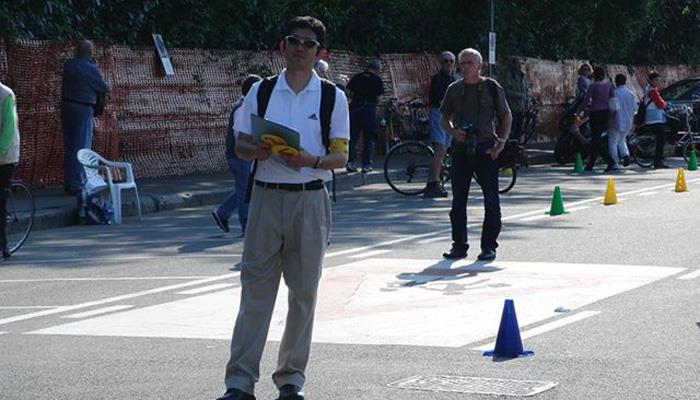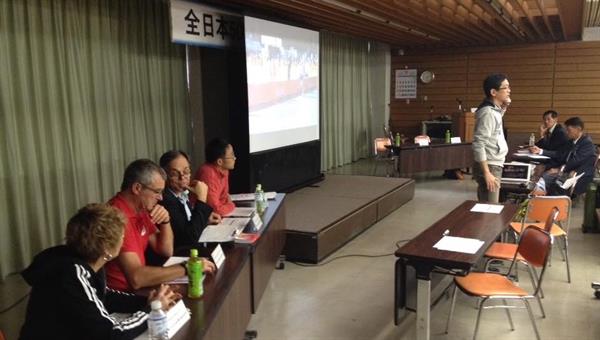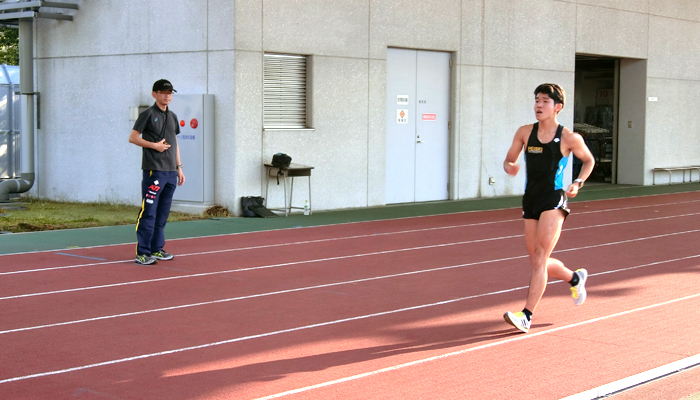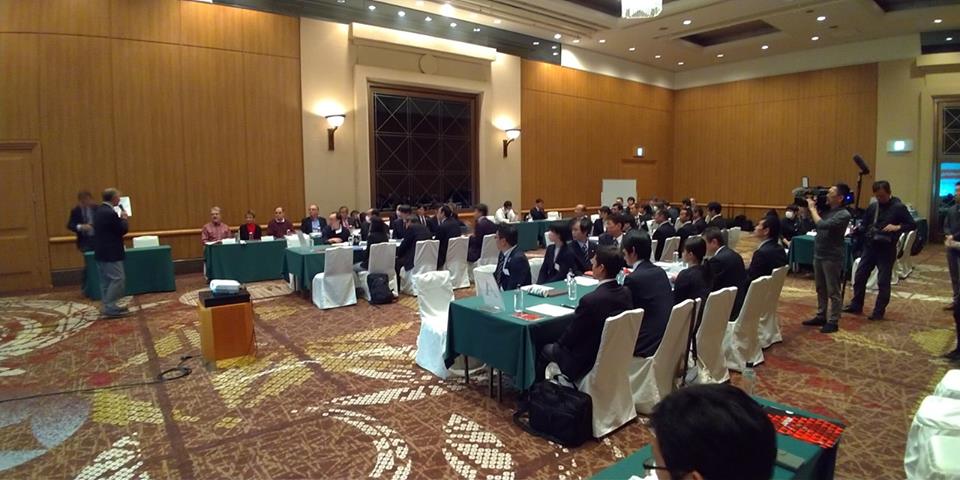We received a long and interesting analysis of the moment of race walking from Koji Hoga Miura (JPN), with particular attention to the debate about 50km.
Koji Hoga Miura is a well-known biomechanical of Japan who collaborates with the team of Japan and a decade ago was also a race walking judge at the Asian Area level.
The analysis ranges between the historical problems of the initial years of the specialty up to our days and finally concludes by indicating the reasons why, in his opinion, race walking is experiencing a particular suffering moment.
We think that his reading is of interest to those who want to deepen the subject seen from a different angle, regardless of whether or not they share ideas.
We want to share it with our readers as it reflects the point of view of a collaborator of what, at the moment, is undoubtedly the strongest team in the world in the 50km: Japan.

Koji Hoga Miura judge in Sesto San Giovanni IAAF Challenge
The crisis on race walking in major competitions
In last five years, the Race Walking are suffering from the crisis to be omitted from Olympic games.
However, the problem has occurred after the Olympic games in Paris 1924. Our history in Olympics from Athens in 1906 has been suspended from 1925 to 1931 as follows:
1906 Athens: 1500m and 3000m
1908 London: 10miles
1912 Stockholm: 10km
1920 Antwerp: 3km and 10km
1924 Paris: 10km as road events
1928 Amsterdam: no race walk events
1932 Los Angeles: 50km
1936 Berlin: 50km
1948 London: 10km and 50km
1952 Helsinki: 10km and 50km
1956 Melbourne: 20km and 50km
The reason why the race walking has been eliminated and expanded the distance after elimination was the problem of judgement.
With the technology of about 100 years ago, it might be impossible to recognize the very short time loss of contact and impossible to judge accurately whether walkers lose contact with the ground or not.
The difficulty of consistent judgement might result in the conflict among athletes and officials. That conflict might cause the elimination of the race walking from the Athletics in Olympics. The solution to return the race walking into the Olympics was the expansion of distance from 10km to 50km. The details how they solved the problem of Judgment were as follows:
- The distance of 50km has seemed to be so much long, then the athletes could not walk fast. So, the officials thought that the results might not be different if they walk in correct technique or incorrect technique and also that if the athletes run, the result would be the same as they walked.
- The distance of 50km has seemed to be so much long to walk fast, they the judgment would be not difficult.
However, during about 90 years after the elimination of race walking from Olympics, the technology of devices has been developed and the technique of athletes has also advanced to high level, as our biomechanical researches has detected some walkers who did not lose contact with the ground.
One was in the experiment of our doctoral study with high speed video camera capturing 250 frames per second, on elite athletes who walked with the speed of 250m/min.
Another one was in the taking video pictures on the first half of Men 20kmW in Olympics of Athens 2004 with normal digital video cameras of 60 frames per second on the one athlete in the leading pack who walked with the speed under 250m/min.
Also, our researches (published only in domestic) in these two decades has revealed inconsistency in the view point of the time length of loss of contact in major competitions. Even if some athletes walked with the same length of loss contact, some received red cards, some received only yellow paddles and some were not received yellow paddle nor red card. Of course, athletes with obvious length of loss of contact time have received plural red cards. As many of athletes, coaches and officials have pointed out these inconsistencies, we should adopt new judging system to conduct consistent and objective judgement.
Now, we can buy high-speed digital video camera which take movies with over 300 frames per second on 300 euros and we can see easily if walkers progress without loss of contact or not.
Now, many male athletes can walk 50km under 3:45:00 which are faster than the Olympic Record of Men 10km marked on 1924 and fast as the Olympic Record of Men 3km marked on 1920.

Koji Hoga Miura lecturer at a biomechanics seminar
If we solve our new crisis of Judgment of race walking (the IOC is recommending us from year 2000) with the same logic before 1932, we could solve only with the expansion of the distance of the Race Walking events from 50km to over 50km, at least 70km or 80km, it may be under 100km. Because the speed of 50km on Olympics of nowadays are faster than that of 10km before 1924, the difficulty of judgment has increased to so much complicated level.
However, if we expand the distance of the race walking, it seems to be impossible to retain the position in the Olympics and the race walking can survive only outside of Olympics like the mountain running, the Ultra ‘100km’ marathon and the ironman triathlon.
The Olympics is not only for Athletics. The Athletics is not only for the Race Walking.
We should share the time, budget and other resources with other disciplines of Athletics and other Sports.
Most of endurance events, like Triathlon, Pentathlon, Bicycles and other Sports in Olympics are now reducing the time and distance with the policy of IOC to share the time and places each other. So, we should solve our crisis with other methods, new system of Judgement, in which we can judge on high-speed walking with consistency and objectivity.
In the policy of IOC in which the Race Walking in Olympics has never realized, there is one important point: the Gender Equality by number of distances and races in our discipline.
From the world championships in 2017, the Women 50km was started with the mixed start with men and competition among men. In order to realize the complete equality between genders, the mixed start is not sufficient and the women’s longer event should be held as complete independent event. However, it seems to be difficult to insert another 4/5 hours of the race time for another new independent event in addition to the race time, shared for the current 3 (4) events of race walking is about 6:55:00, based on the entry standards for 2019 Doha
- Men 50km: 3:59:00;
- Men 20km: 1:22:30;
- Women 20km: 1:33:30.
However, by the changing distance from 20/50km to 10/30km, it might make possible to hold 4 events which will accomplish the gender equality in the following assumption:
- Men 10km: 45:00,
- Women 10km: 50:00
- Men 30km: 2:20:00 (Total : 3:55:00).
Then, the difference from 6:55:00 is 3hours, it might be enough to have another women’s longer event with 30km. 35km for men and women would be over current sharing time 6:55:00.
With the shortening of distance, especially in the change from 50 to 30km, the property of event seems to change.
However, is the tenacity and persevering with the distance is the first and second peculiarity for the Race Walking? If these properties are the first two, the history of race walking in Olympics started as the long-distance event outside of stadium like the Marathon about 110 years ago. If we would change the distance to the one 100metres or 1mile, the race walking is the race walking. The characteristics of discipline are all the same in one hundred meters or fifty kilometers.
Someone say that “The race walking will be died, if the 50km will be changed to 30km.”. But, is the technique of 50km completely different from that of 30km? The 30km event will have the same peculiarity: “The technique of the Race Walking” as the 50km event.
The difference between 30km and 50km may be if the tenacity and persevering with the distance is sever or not. But, are these peculiarities of 50km supported by the Athletics in the world in these years?
One of the IOC’s evaluations for the Race Walking in Olympics was the support with the young people. The number of the support with young people to the 50km event might be evaluated the number of competitions and the participants of 50km events. We can see the list of 50km under 4:15:00 after 2003 on the website of IAAF.
The following data is the annual number of 50km competitions with performances under 4:15:00 except for the World, Area and Nation-Groups competitions and the number of countries which held these 50km competitions.
2003 Competitions: 26; Countries: 24
2004 Competitions: 21; Countries: 17
2005 Competitions: 21; Countries: 18
2006 Competitions: 21; Countries: 18
2007 Competitions: 24; Countries: 21
2008 Competitions: 15; Countries: 12
2009 Competitions: 23; Countries: 19
2010 Competitions: 21; Countries: 17
2011 Competitions: 21; Countries: 16
2012 Competitions: 16; Countries: 13
2013 Competitions: 15; Countries: 13
2014 Competitions: 17; Countries: 14
2015 Competitions: 11; Countries: 10
2016 Competitions: 16; Countries: 13
2017 Competitions: 18; Countries: 14
2018 Competitions: 22; Countries: 17
All we can see that the number of competitions and countries which held competitions are very small in comparison with the number of member federations of IAAF and the reducing of these numbers. Also, during the entire these 15yeras, the number of competitions which had over 10 participants including over 4:15 athletes except for the World, Area and the Nation-Groups competitions were very small: in Dudince 50km in Slovakia, Spanish 50km championship, IAAF Challenge in Mexico, Chinese domestic 50km competitions 2 or 3 times a year and Japanese domestic 50km competitions 2 times a year.
If the tenacity and persevering with the distance have been supported with many young athletes, more competitions with more participants would be held in all over the world in these 20 years and the population and the number of competitions for 50km race walking would be expanded. But, some of high level 50km competitions has been diminished from the high-performance list of IAAF in these 20 years. Naumburg, Dublin, Bergen and others, which were on the top tier of world list in the past.
The tenacity and persevering as the endurance event and the methodology to train for high-level these characteristics are the important peculiarity for 50km and the important value as human ability to be competed in high level. However, we are now in the crisis in which the support for one of our peculiarity of endurance are reducing. Now, we are in the time to change our system into the new one with the reducing the distance in order to attract many supports for our discipline.
In Japan, many people in the Race Walking and the Athletics has built the gradual development system from the youth-distance, 5000m to the senior 50km. Within this development system, they understand the value of endurance events. Then, most of Japanese elite 50km athletes expanded their target events after they walking almost under 1:20:00 in 20km. The performance in 50km might be not independent from the performance in 20km and the shorter events. Also, the performance in 20km might be not independent from the performance in Junior and Youth events.
In my opinion, the superficial opposition to the new system could not activate positively our discipline.
We should adopt new judging system and the new distance and we should improve athlete development system for our future.
In conclusion, the proposal for the council of IAAF seems to be aimed to solve these two points in order to improve our discipline, from outside of IAAF.
- To solve long-term problem of Judgment.
- To realize the complete gender equality.
These two points may likely push our back in order to accept the package of four point proposal for our sustainable future of race walking as Athletics.
Koji Hoga Miura (JPN)

Koji Hoga Miura in training

Kobe seminar 2019

(Japan version in short)
今回の改革案の骨子は以下の2点
1)男女同一種目の完全実施
2)100年続く判定問題の解決
2)については「肉眼判定」の良さ、スポーツとしての意義の重要性を感じるところではありますが、オリンピックがその時代時代で最新のテクノロジーの先導的な役割を果たしてきたこと、1928年アムステルダム大会での判定問題による種目除外の歴史を考えると、新システムの導入やむなしとも思います。
また、1924年パリ大会まで10kmだったのが1932年ロサンゼルス大会で50kmとなって復活した経緯は「50kmであれば走ろうが、歩こうが大して記録は変わらないから、少々の見逃しがあっても競技結果には有利に働かないだろう」というものだったとされています。
そこから約90年を経て、ビデオカメラは発達し、選手の記録は伸びて、今や50kmWの世界選手権・オリンピックトップ8レベルのスピードは1924年までの10kmWのオリンピック記録のスピードを上回っており、同じ論法で判定問題を解決しようとすると70, 80kmないし100kmまで距離を伸ばすことになって、スリム化が求められる世界選手権・オリンピックの枠内からはみ出ることになります。
実際に、IAAFでは競歩種目は世界チーム選手権のみの実施として、世界選手権では実施しない(代わりにクロスカントリー競走を実施しては)という議案がでたことも近年ありました。
この点は1)とも関係して、2017年から男女同時スタートで女子50kmWが実施されるようになりましたが、男子のレースの中に入っての実施では、男子競技者の影響による有利不利(ペースメイキングなど)が発生して、完全な男女同一種目とは言えません。とはいえ、標準記録or世界トップ30ラインベースで考えて4時間30分の競技時間を現行3種目の合計7時間に加えて実施するのは「スリム化」の流れに逆らうことになるので実現困難でしょう。
男子50kmWの世界選手権・オリンピック参加標準レベルの選手数こそこの15-20年であまり変わらないとはいえ、世界チーム選手権の男子50kmW参加国数、各国連盟主催の50kmW競技会数・開催国数は確実に減少しているほか、現在自国参加者20名以上を集める50kmWの大会を開催しているのがメキシコ、スペイン、中国、日本のみという現状では、「陸上競技大会」全体での競歩の実施枠拡大を求めるにはなかなか根拠に乏しいと言わざるを得ません。
こういった状況で男女4種目を実施しようとなると、現行の7時間枠の中での実施で訴えるのは極めて妥当で、そこで10km-30kmだと、男子10km: 45分、女子10km:50分、男子30km:2時間20分で合計3時間55分、残り3時間05分となって十分に女子30kmに充てる時間が確保できる計算となります。35kmだとオーバーすることになります。
種目距離の変更だけが一人歩きして様々な反対意見は出ていますが、50kmWを残せとはいっても、IAAFサイトで検索可能なこの15年の50kmWの4時間15分以内のパフォーマンスを見ると、全体のパフォーマンス数は変わらないもののその実態としてはヨーロッパ、オセアニアの選手層が薄くなって、その代わりにアジア、南米の数が増えていったというものです。
反対議論はあるにせよ、「とにかく50kmWを残せ」というものばかりで、なぜ選手数が減ったのか?なぜ競技会数が減ったのか?その要因が何で、解決には何をすべきだったかといった議論が全くないものが多く、少々辟易しています。
日本のこの20年を振り返れば、ユース種目の5000mWからシニアトップ種目の50kmWに至るまでのしっかりと組織だった競技会システムを構築してきたからこそ、そこで育った今の選手の今があるわけで(そしてシステムがあって20kmWで十分に育ってから50kmWに距離を伸ばしている以上、30kmWに変わっても出てくる選手の国際レベルでの位置は50kmWと変わらないでしょう)、選手数・国際的な普及・育成・強化のための育成システムの議論もなく(そしてその構築や競技会の充実策も、IOCからの勧告による危機に至るまで何もなく)ただ反対ですと言われてもなぁ、というところです。